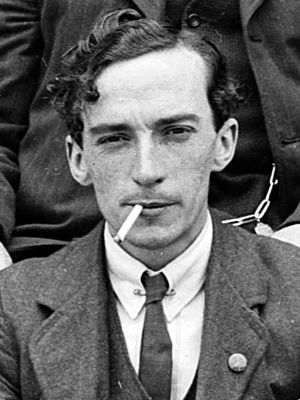Cathal O'Shannon facts for kids
Quick facts for kids
Cathal O'Shannon
|
|
|---|---|

O'Shannon in August 1918
|
|
| Teachta Dála | |
| In office June 1922 – August 1923 |
|
| Constituency | Louth–Meath |
| Personal details | |
| Born |
Charles Francis Shannon
9 June 1890 Randalstown, County Antrim, Ireland |
| Died | 4 October 1969 (aged 79) Dublin, Ireland |
| Political party | Labour Party |
| Other political affiliations |
Socialist Party of Ireland (1912–1917) |
| Spouse | Margaret Finn |
| Children | 3, including Cathal |
| Education | St Columb's College |
| Occupation | Trade union leader, Journalist |
Cathal O'Shannon (born Charles Francis Shannon) was an important Irish politician, a leader for workers' rights, and a journalist. He was born on June 9, 1890, and passed away on October 4, 1969. He played a big part in shaping Ireland during a time of major change.
Contents
Early Life and Influences
Cathal O'Shannon was born in Randalstown, County Antrim. He was the third child of Charles and Alice Shannon. His family later moved to Draperstown, County Londonderry, his mother's hometown. His father worked on the railway there.
Growing up, Cathal was inspired by his family and the local area. He became interested in trade unionism (groups that protect workers' rights), the Irish language, and Irish Republicanism (the idea of an independent Ireland). He went to school in Draperstown and then to St Columb's College in Derry. At college, he studied history and found a love for journalism. After his father died, he moved to Belfast to train for a job in the civil service.
Becoming a Republican and Activist
While in Belfast, Cathal joined Conradh na Gaeilge, a group that promoted the Irish language. He also started writing articles for newspapers like Peasant and Sinn Féin. Around this time, he joined a secret group called the Irish Republican Brotherhood. This group worked for Irish independence. He also helped run the Belfast branch of Na Fianna Éireann, a nationalist scout group for boys.
By 1910, Cathal stopped his studies and worked as a clerk for a shipping company in Belfast. Here, he saw arguments between workers and divisions between different religious groups. This made him even more interested in trade unions and socialism (a system where society controls wealth). In 1912, he joined the Irish Transport and General Workers' Union (ITGWU). He became an assistant to James Connolly, a very important leader in the Irish workers' movement. Connolly inspired Cathal to join the Socialist Party of Ireland.
In 1913, Cathal helped start the Irish Volunteers in Belfast. This was a group formed to protect Irish rights. On Easter Sunday in 1916, he gathered with other Volunteers in Coalisland, County Tyrone. However, they went home because they didn't receive orders from Dublin. He was later arrested by the British authorities and held until 1917. He was arrested again later and went on a hunger strike, being released after seventeen days.
After his release, O'Shannon worked in cities like Dublin and Cork. He helped keep the ITGWU strong after James Connolly's death. He also became more involved in politics, supporting the idea of workers taking control of their workplaces. These actions were called "Irish soviets."
In 1920, Cathal traveled to Britain to speak about the Irish fight for independence. He wanted to gain support from British workers' groups. He was arrested in April 1920 for this and sent to prison. But he was released after an 8-day hunger strike.
When peace talks for the Anglo-Irish Treaty began in 1921, O'Shannon urged leaders not to give up on recognizing an independent Irish Republic. When the treaty was signed, he believed the Irish Civil War was a distraction. He thought the real fight should be about workers' rights.
Becoming a Politician
Even though he was known as a strong socialist, Cathal O'Shannon was elected to Dáil Éireann (the Irish parliament) in the 1922 Irish general election. He became a TD (a member of parliament) for the Labour Party in Louth–Meath. He received almost 40% of the votes, which was twice as much as the next candidate.
As a Labour Party leader in the Dáil, he often criticized the government. He was especially against a law that gave the army special powers. He also spoke out against the execution of anti-treaty prisoners, calling it a "great crime."
He was not re-elected in the 1923 Irish general election for the Louth area. The Labour party's overall votes dropped a lot that year. He also tried to get elected again in Meath in 1927 but was not successful.
Later Years and Family
Even after leaving parliament, Cathal O'Shannon remained an important figure in the Labour movement. He focused on trade union work. He edited newspapers like The Voice of Labour and The Watchword from 1930 to 1932. In 1941, he became Secretary of the Irish Trades Union Congress. Later, he led the Congress of Irish Unions.
From 1946 until his death, he served for twenty-three years as a representative for workers on the Labour Court. This court helps solve disagreements between workers and employers.
In 1924, Cathal O'Shannon married Margaret Doris Finn from Stockport, Cheshire, England. They had met when Cathal was working in Britain during the Irish War of Independence. They had three children: one son and two daughters. Their son, also named Cathal O'Shannon, became a well-known Irish TV presenter and journalist. Their daughters, Gráinne and Finola, were involved in acting and making films.
Cathal O'Shannon passed away in Dublin on October 4, 1969, at St Laurence's hospital. He was buried in Deans Grange Cemetery.
Images for kids


